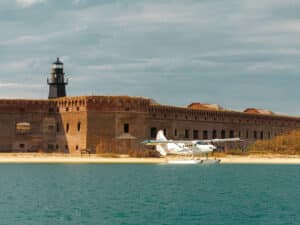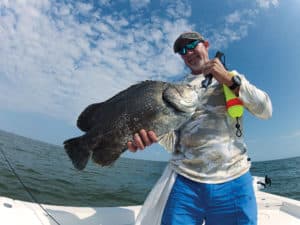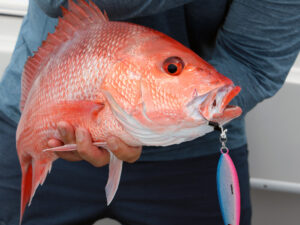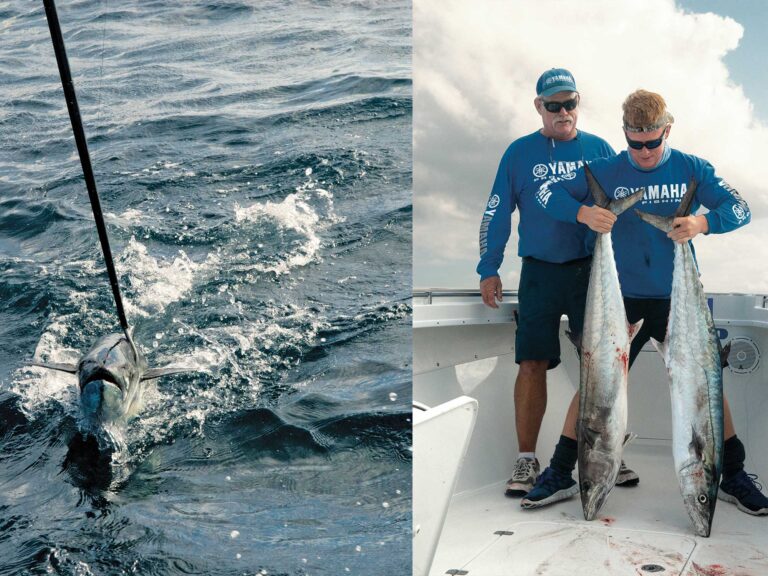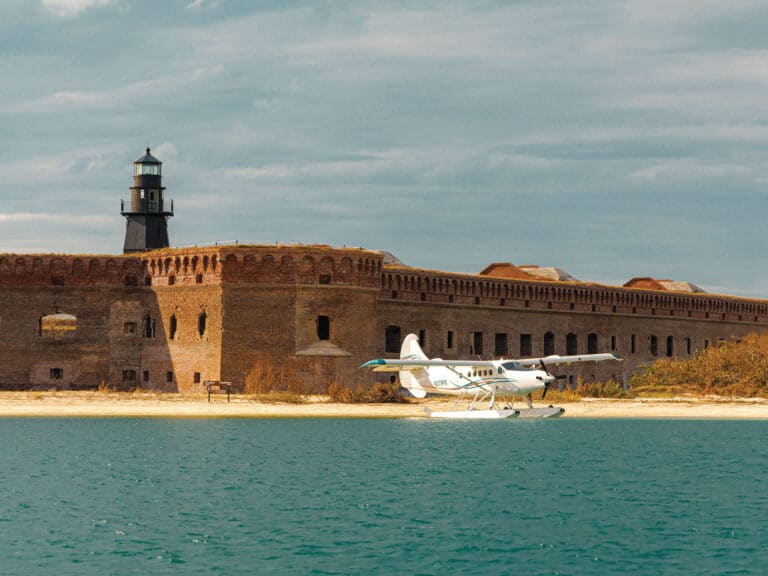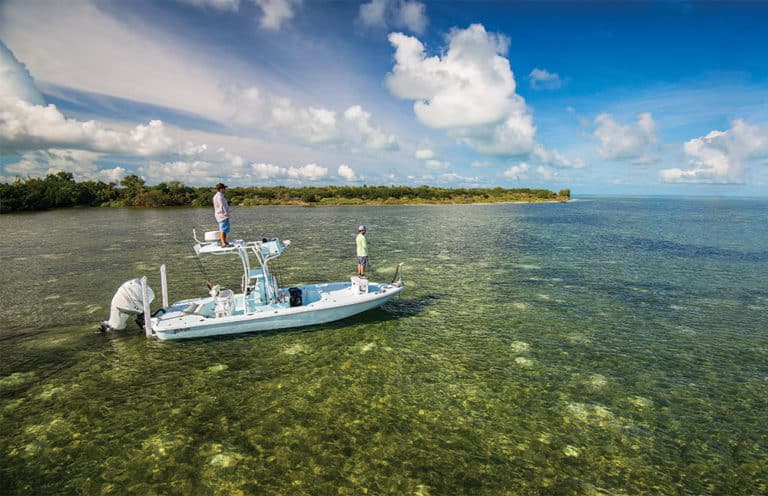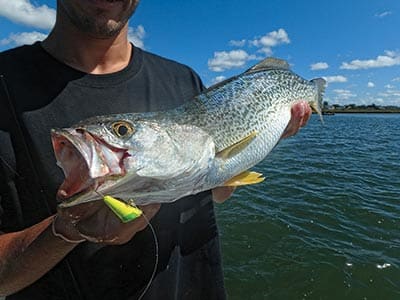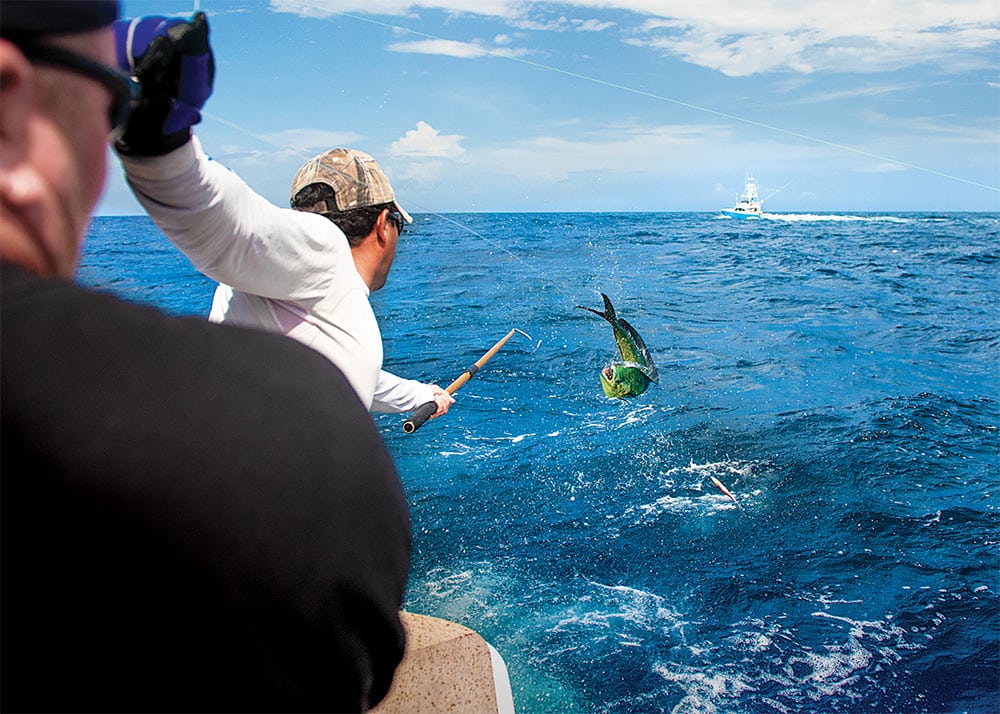
“There has to be dolphin here,” I mumbled while surveying our surroundings.
Terry Flora, Carl Grassi and Columbia Sportswear’s Brent Brauner didn’t chime in. We rested our topwater plugs and free-lined a couple of live pilchards along a large, bait-rich weed patch. Suddenly, Brauner yelled, “Frigate!” and pointed a quarter-mile ahead.
With MARC IV on plane, we raced toward the now-diving, prehistoric-looking bird. A moment later, our topwater plugs lured in a threesome of dolphin. We reveled in the hectic three-at-once fight, then within minutes they were on ice in our fish box. Because of his keen eyesight and awareness, we duly bestowed upon Brauner the nickname “Frigate.”
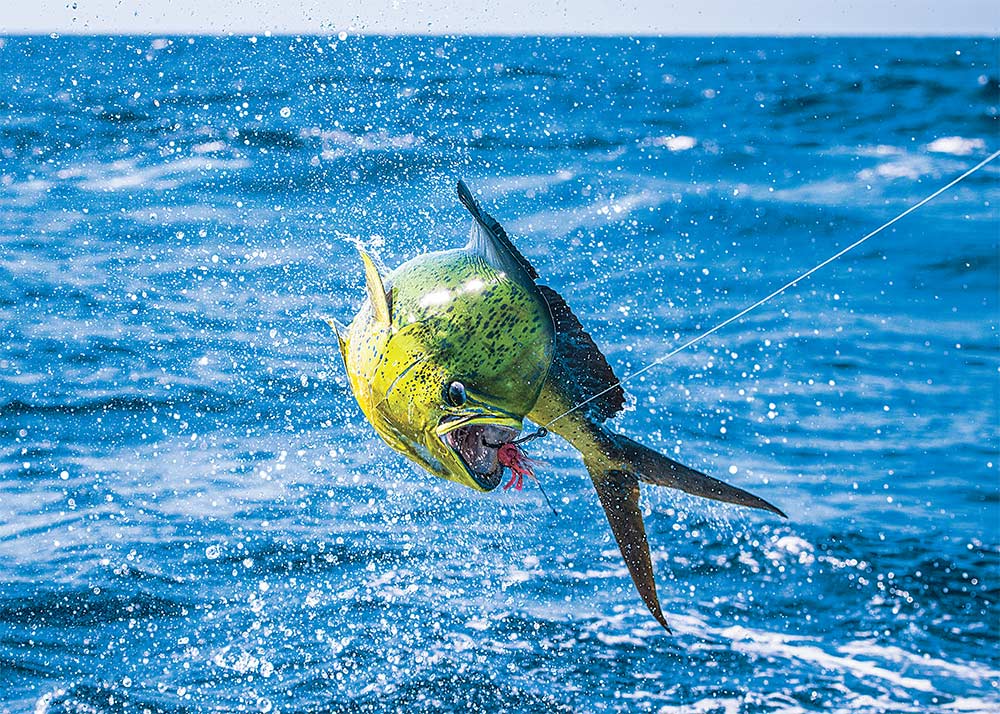
Hunting Grounds
The large swath of sea separating Little Bahama Bank and Great Bahama Bank — known as Northwest Providence Channel along its western front, and Northeast Providence Channel along its eastern stretch — always intrigues me. This pelagic passageway between the Gulf Stream and open Atlantic Ocean off the eastern Bahamas holds incredible bottom structure, currents and eddies. As you approach the western entrance, there’s a mixing of the north-flowing Gulf Stream and currents from within the channel. Rips and weed lines consistently form along this convergence zone. The straight-line distance across its western mouth is 30 miles, from Little Isaac to the south and Freeport to the north. From west to east, it’s roughly 115 miles.
The convergence of currents along the western side attracts dolphin, sailfish, marlin, wahoo, and blackfin and yellowfin tunas. And some monstrous sharks. Well within the channel itself, numerous canyons, mounds and radical bottom structure provide feeding stations for yellowfin tuna.
Mahi on the Move
Spring is king here. Dolphin migrate hard through the Bahamas, with blue marlin bird-dogging them. It’s also prime time for yellowfin tuna, because temperatures are still cool enough to hold them in the upper part of the water column; come summer, tuna action reverts to daybreak and late afternoon. And while the winter wahoo migration has passed, there’s still a puncher’s chance to score one, particularly during the full moons of July and August.
If fishing here during spring comes with a price, it’s often those late-season cool fronts and strong easterly breezes, which, in conjunction with the mix of currents along the channel’s mouth, breed confused seas that can be an absolute bear to navigate.
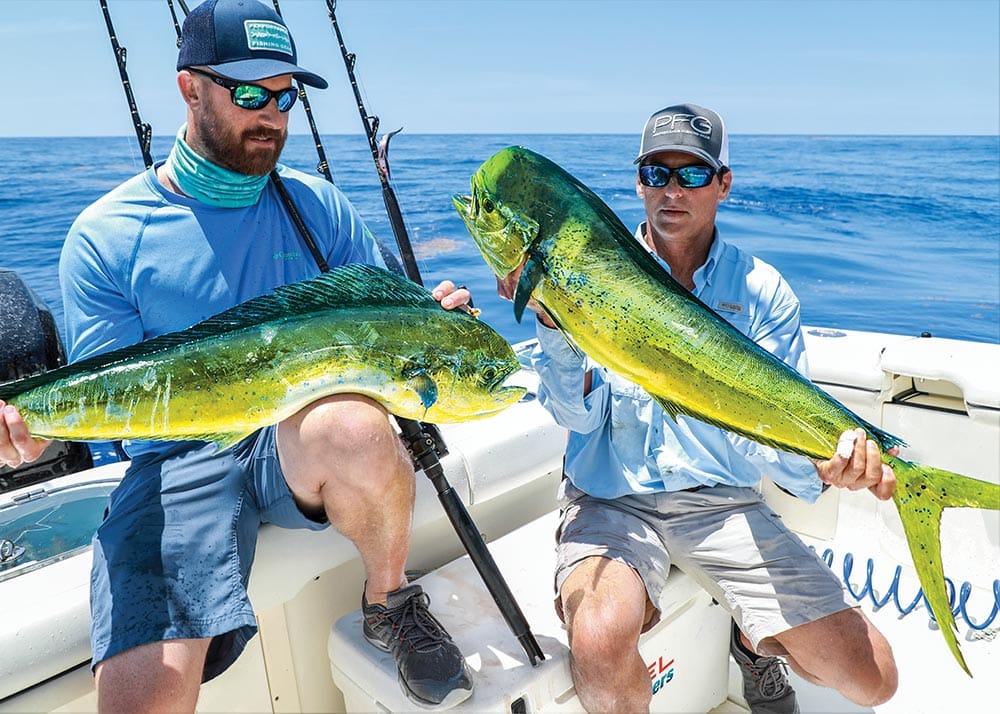
Channel Two-Step
Running and gunning is effective in locating both dolphin and tuna. Early-morning runs are devoted to tuna hunting, with dolphin-hustling filling the void until the late-afternoon tuna refocus. Of course, dispatching a full spread of trolling baits is an option. But remaining mobile and on the lookout for weeds, debris and working birds is the fast path to success.
Radar Love
Birds tell all out here, and radar offers a major advantage in finding them.
I set the radar’s outer range at 4 miles, in Bird Mode, and headed north- northeast toward the Grand Bahama side, consulting the radar and scanning the sea for weeds and debris. Halfway across the channel, the radar marked birds holding over a spot.
Three birds led us to a stretch of heavily scattered weeds, which ultimately spanned several miles. Ironically, some sections were thriving with bar and almaco jacks, and droves of smaller forage species, whereas other sections were devoid of this critical food-chain component. Our strategy was to chase birds and — in between radar sightings — devote 15 minutes to fishing along large weed patches rich with bait.
Read Next: Fishing Grand Bahama Island
Green, Yellow and Blue
A range of 3500- to 7500-class spinning outfits carrying lines from 8- to 20-pound-test stood ready, pre-rigged with 30- and 40-pound fluoro leaders, bucktails and J hooks from 4/0 to 7/0, set to sling a smorgasbord of baits ranging from live pilchards and goggle-eyes to fresh squid, small whole ballyhoo and ballyhoo chunks. Our dinner-bell outfit was a 6500-class spinner filled with 50-pound braid and rigged with a 50-pound fluoro leader and topwater chugger.
We’d first pitch the chugger at a stop, retrieving it in panic fashion. The ensuing splashing and noise called in dolphin from afar. Many times, a dolphin clobbers the plug, with schoolies following. Sometimes dolphin simply chase it to the boat. Either way, when dolphin appear within casting range, out go the baited spinners. That topwater plug worked wonders for us.
Systematic Rotation
To hold dolphin around the boat, double- and triple-up on the hooked ones kept in the water. The traditional single-fish-in-the-water trick no longer works as well as it did years ago. Today the greater number of hooked fish that remain in the water, the longer the party lasts. When rotating them into the fish box, remove the one that was in the water the longest. Have that angler rebait, cast and hook another. Then rotate out the fish that was in the water the second longest.
We didn’t experience large numbers of small schoolies on this particular trip, but rather pairs and sometimes pods of larger dolphin, which are more the norm within the channel. Peanut dolphin just don’t last long here, given the abundance of predators stalking them.
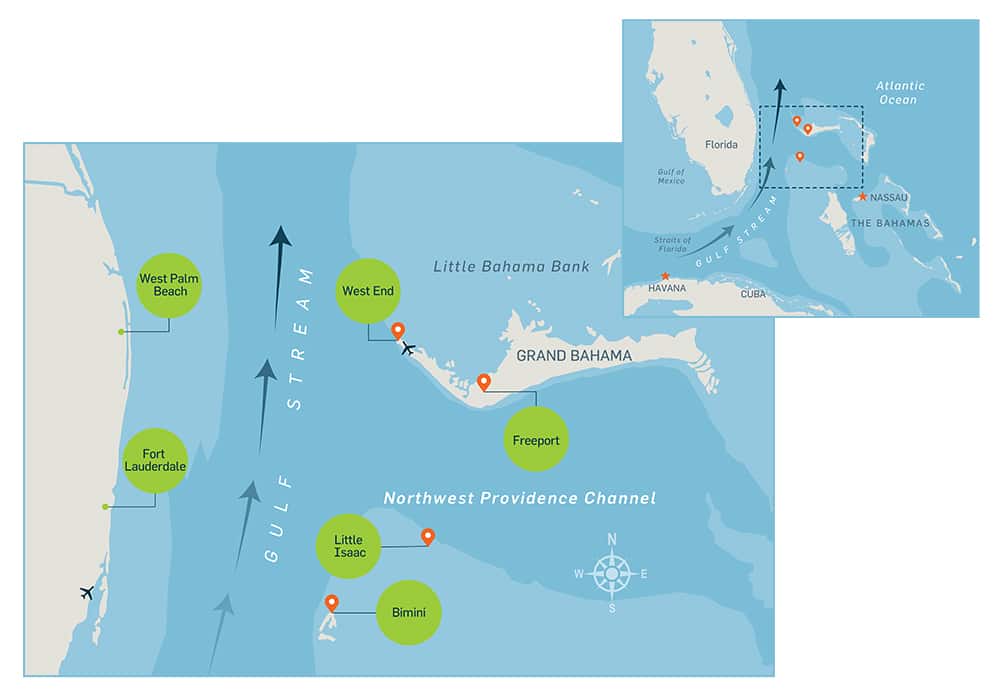
Yellow Fever
Yellowfin tuna are arguably the headliners in the channel. Cooler spring water temperatures keep them active. However, excellent tuna fishing often lasts well into September.
We plugged away for dolphin until late afternoon, then intently watched for birds on radar while cruising toward a deep canyon.
We found them gathering in the canyon. We shut down and free-lined goggle-eyes and pilchards at the surface, and staggered two goggle-eyes in the water column. Our tuna tackle consisted of two-speed Penn International 16 and Torque 40LD2 reels with 50-pound Smoke Blue mono, 30-foot wind-on leaders of clear 50-pound fluoro, and 3X strong, 3/0 circle hooks. The stand-up rods were rated for 50 to 100 pounds.
Terry Flora was first to slug it out with a yellowfin. About 15 minutes later, when he seemed to have broken the fish’s spirit and had it coming his way, something big intercepted it. As feared, a shark took his tuna.
We regrouped and soon hooked another yellowfin, which pulled the hook. Strike two! With an hour of light remaining, Grassi hooked up. I clenched my grip on the gaff upon catching a glimpse of the 40-pound yellowfin. Then, just 10 feet beneath the boat, two sharks charged the tuna and claimed our prize.
That’s how it goes sometimes. Often yellowfins can be kept around the boat by chumming heavily with live pilchards, or heavily chunking with cut Spanish sardines. Or you can simply combine a spread of surface- and deep-placed live baits.
One trick is to take a measured approach to chasing birds. Study their pattern. Often they’ll follow tuna as they make wide circles over an area. So, if you’re in the zone, sit for a bit and see if the fish circle back your way.
It’s a Long Way There
Whether you’re based in Bimini, or the Old Bahama Bay or Blue Marlin Cove areas by West End, the typical yellowfin grounds demand a 30- to mid-40-mile run. Freeport can be closer to the action, but long runs are still common.
Despite the long haul, the intrigue keeps me coming back. If you want to try this place, plan a trip in the spring. Catch a break with the weather, and you too will become hooked for life.
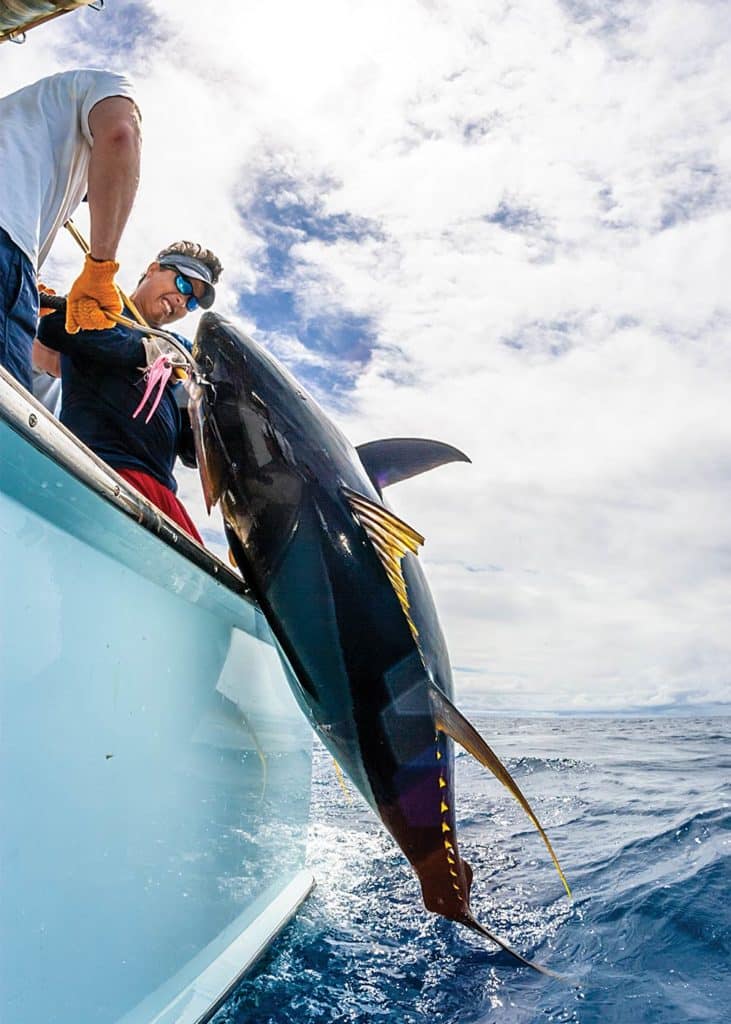
The Way It’s Supposed to Be
Well-positioned to take advantage of Northwest Providence Channel, the Bimini Big Game Club Resort and Marina (biggameclubbimini.com) offers rooms, suites and cottages, each outfitted with cable TV and Wi-Fi. There’s a pool, a bar and lounge, restaurant, business center, shops and meeting facility. Boat slips offer power and fresh water. Ice is available, and there’s a large freezer where chum and baits may be kept until you need them. It’s a popular base for South Florida anglers visiting Bimini. Make reservations, because the place sells out on those perfect-weather weekends.
SWS Planner – Bahamas Spring Dolphin and Tuna
What: Dolphin and yellowfin tuna
When: March through June
Where: Northwest Providence Channel, the Bahamas
Who: Private boats routinely cross to Bimini or Freeport from Florida ports to tap into the migration. So do these top charter captains:
Fort Lauderdale, Florida – Capt. Dean Panos
954-805-8231
doubledcharters.com
Miami – Capt. Bouncer Smith
305-439-2475
captbouncer.com
SWS Tackle Box – Bahamas Spring Dolphin and Tuna
Rods: For dolphin, Penn Spinfisher VI, 3500 to 6500. For tuna, Penn Torque 30LD2 and 40NLD2 and International 16, or equivalents.
Reels: For dolphin, Penn Battalion, 7-foot 12- to 20-pound class. For tuna, Penn Legion, 7-foot 12- to 20-pound conventional; Penn International, 6-foot 50- to 80-pound class, or equivalents.
Line: For dolphin, 12- and 20-pound mono, 30-pound braid. For tuna, 80-pound braid with 50-pound monofilament top shot, or straight 50-pound monofilament.
Lures: Williamson Popper Pro 130, for dolphin and tuna
Bait: Live pilchards and goggle-eyes, fresh ballyhoo
Rigs: For dolphin, live-bait hook, 4/0 to 7/0. For tuna, single non-offset circle hook 3X strong, 2/0 and 3/0.

